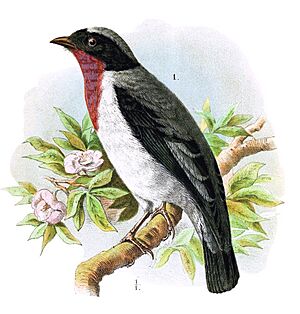Cherry-throated tanager facts for kids
Quick facts for kids Cherry-throated tanager |
|
|---|---|
 |
|
| Saíra apunhalada | |
| Conservation status | |
| Scientific classification | |
| Genus: |
Nemosia
|
| Species: |
rourei
|
 |
|
|
approximate range
|
|
| Synonyms | |
|
Nemousia rourii (lapsus) |
|
The cherry-throated tanager (Nemosia rourei) is a beautiful medium-sized bird. It is a type of tanager and is known for its bright black, white, and red feathers. This bird is very rare and is found only in a few places in the Atlantic Forest in Espírito Santo, Brazil. It is considered critically endangered, meaning it is at high risk of disappearing forever.
Contents
What Does the Cherry-throated Tanager Look Like?
This bird has a striking appearance. Its upper body is mostly grey, with a darker back and a lighter head. A wide black "mask" covers its eyes and forehead. A thin white line runs above this mask.
Its wings and tail are black. They have a blue shimmer, especially on the wing feathers. The belly is white, and the throat has a bright cherry-red patch. This red patch can be larger or smaller on different birds.
The feet and toenails are light pink, and its eyes are dark yellow.
Males, Females, and Young Birds
Male and female cherry-throated tanagers look very similar. Females might have a slightly smaller red throat patch. Young birds have a dull brown throat patch instead of red.
How Big Are They?
The first cherry-throated tanager ever studied was about 14 cm (5.5 in) long. Its wings were about 8.3 cm (3.3 in) and its tail was about 6 cm (2.4 in). Another bird measured later was a bit smaller, around 12.5 cm (4.9 in) long, and weighed about 22 g (0.78 oz).
What Do They Sound Like?
The cherry-throated tanager has a clear, loud call. It sounds like a single note or a quick series of two or three notes. Sometimes, these calls are followed by two higher-pitched notes. The bird can sing a short "song" that mixes these calls with a faster chittering sound.
Discovery and Rediscovery
This bird was first described in 1870. Scientists only had one bird specimen to study at that time. This specimen was collected by Jean de Roure and sent to scientist Jean Cabanis, who gave the bird its scientific name. For over 100 years, this was the only known specimen.
In 1941, a famous bird expert named Helmut Sick saw a group of these birds. But he didn't realize what they were until much later. It wasn't until 1995 that a bird matching the description was seen again. This sighting happened at the Augusto Ruschi Biological Reserve in Brazil.
More sightings followed, confirming that the cherry-throated tanager was still alive. In 1998, it was definitely rediscovered at a private woodland called Fazenda Pindobas IV. In 2003, its presence was also confirmed in Caetés Forest. These places are now important for the bird's survival.
Scientists have searched for the bird in other areas, but so far, it has mostly been found in Espírito Santo state. In 2019 and 2020, more birds were seen and even photographed at the Águia Branca Private Reserve.
Where Do They Live and What Do They Eat?
Cherry-throated tanagers live in Atlantic Dense Montane Rainforest areas. They are found at altitudes between 850 m (2,790 ft) and 1,250 m (4,100 ft) above sea level. They prefer dense forests and usually avoid open areas or tree farms. However, they might use these areas as pathways if the trees are thick enough.
These birds can be seen alone, in pairs, or in small groups. They seem to stay in the same area all year round. Like many tanagers, they often join mixed-species feeding flocks. These are groups of different bird species that travel and feed together.
Cherry-throated tanagers mainly eat small invertebrates. These include caterpillars, butterflies, ants, and other arthropods. They find their food by looking under leaves and climbing through branches.
Status and Conservation
The cherry-throated tanager is listed as critically endangered by the International Union for Conservation of Nature. This means it faces an extremely high risk of extinction in the wild. Scientists estimate there are only between 30 and 200 adult birds left. Their habitat covers a very small area, only about 31 km2 (12 sq mi).
The biggest threat to these birds is deforestation. When forests are cut down, their habitat shrinks and becomes broken into smaller pieces. This makes it harder for the birds to find food, mates, and safe places to live.
There are efforts to protect the areas where these birds live. For example, Fazenda Pindobas IV is working to become a protected reserve. The cherry-throated tanager is a beautiful and unique bird. Its striking looks and rarity could make it a "flagship species." This means it could help raise awareness and support for protecting the entire Atlantic Forest and its many other rare animals.


